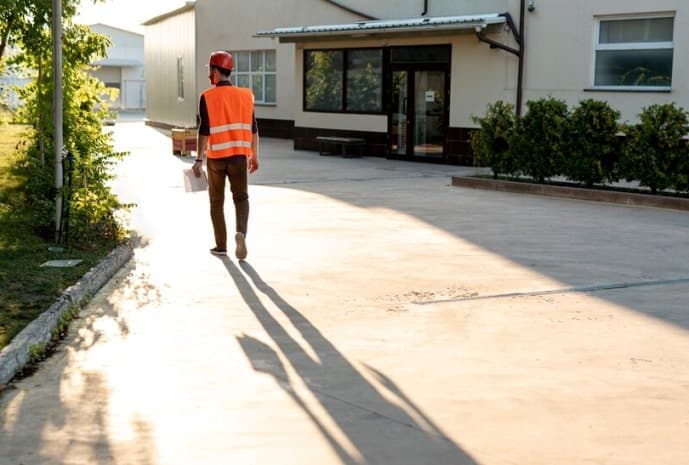Pouring concrete on your property can be an excellent way to enhance your outdoor space, create a sturdy foundation, or build various structures. When it comes to pouring concrete near your property line, questions often arise regarding the allowable distances. The rules can vary significantly depending on the nature of the structure – whether it’s your primary dwelling or secondary outbuildings.
For instance, primary dwellings might necessitate a minimum distance of 10 feet from the sidelines, ensuring adequate spacing. On the other hand, secondary structures or outbuildings may have a more lenient requirement, allowing for placement as close as 5 feet away from the boundaries.
While some communities impose strict regulations on the proximity of driveways to boundaries, others offer more leniency. Surprisingly, many places lack regulations concerning the distance of fences from property lines.
In this article, we’ll cover everything you need to know, from the legal aspects to practical considerations, ensuring a smooth and successful project.
How Close to My Property Line Can I Pour Concrete?
Pouring concrete near your property line requires careful planning and adherence to local regulations. Below, we’ll delve into specific aspects that will guide you through the process:
Familiarizing with Local Zoning Laws
Before starting any concrete work, it’s essential to check your local zoning laws and building codes. These regulations dictate the minimum distances required between your property line and any concrete structures.
Visit your local municipal office or check their website for detailed information.
Understanding Setback Requirements
Setback requirements refer to the distance between your property line and the nearest point of your concrete structure. These requirements can vary based on your location, property size, and the intended purpose of the concrete structure.
Some areas may have different setback rules for front, side, and rear property lines.
Read Also: Mistakes to Avoid for First Time Home Renovation Projects
Consult with a Professional Surveyor
To ensure accuracy, it’s wise to hire a professional surveyor who can precisely mark your property boundaries. This step is crucial, especially if you have any doubts about the property lines or if you share boundaries with neighbors.
Obtaining Necessary Permits
In most areas, pouring concrete within a certain distance of your property line will require permits. Applying for these permits should be done well in advance to avoid delays in your project. Check with your local building department for the specific permits you need.
Considering Easements and Right-of-Ways
Your property might have easements or right-of-ways that limit where you can pour concrete. These areas are designated for utility access or public use, and building on them may not be permitted.
Identify any easements on your property before planning your concrete project.
Engaging with Your Neighbors
Open and transparent communication with your neighbors is essential before embarking on any project that could impact them. Inform them about your plans to pour concrete near your property line and address any concerns they might have.
Building positive relationships with neighbors can help prevent potential conflicts and make the construction process smoother.
Evaluating Soil Conditions
Understanding the soil conditions on your property is crucial, as unstable soil can lead to structural issues with your concrete. Consider conducting a soil test or seeking advice from a geotechnical engineer.
Choosing the Right Concrete Mix
Selecting the appropriate concrete mix for your project is vital, especially if you’re pouring close to your property line. A professional concrete supplier can recommend the right mix based on the intended use and the distance to the property line.
Installing Proper Reinforcement
Proper reinforcement is essential for concrete structures that are close to property lines. Rebar or wire mesh can enhance the strength and durability of the concrete, preventing cracks and other damages.
Providing Adequate Drainage
Proper drainage is a crucial aspect of concrete placement near property lines. Improper drainage can lead to water pooling, erosion, and even structural damage.
Ensure that the concrete is sloped away from your property line and that any adjacent drainage systems are functioning correctly.
Complying with Safety Regulations
Safety should always be a top priority when working with concrete. Adhere to safety guidelines to prevent accidents and injuries during the construction process.
Monitoring Weather Conditions
Weather conditions can significantly impact the pouring and curing of concrete. Avoid pouring concrete during extreme temperatures or rainy weather, as these conditions can compromise the quality of your project.
Taking Care of Property Aesthetics
Consider the visual impact of your concrete structure from your property line and your neighbors’ viewpoints. Incorporate landscaping elements or architectural features to enhance the aesthetics of the project.
Regular Maintenance
Once your concrete project is complete, ensure proper maintenance to extend its lifespan. Regular inspections and repairs will keep the structure in optimal condition.
Addressing Disputes
In the unfortunate event of a dispute with neighbors regarding the concrete structure, try to resolve the issue amicably. If needed, seek legal advice or mediation to find a suitable solution.
Exploring Alternative Materials
If local regulations or restrictions make pouring concrete close to your property line challenging, consider alternative materials like pavers, gravel, or permeable surfaces.
Ensuring Environmentally Friendly Practices
Promote environmentally friendly practices throughout your concrete project. This could include using eco-friendly materials, managing waste responsibly, and preserving existing vegetation.
Creating Pathways and Walkways
Concrete walkways can add both functionality and aesthetics to your property. Ensure you adhere to property line regulations while constructing them.
Building Retaining Walls
Retaining walls can prevent soil erosion and add dimension to your landscape. Be mindful of setback requirements when constructing these walls.
Conclusion
Knowing how close you can pour concrete to your property line is essential for any successful concrete project. By understanding local regulations, considering your neighbors, and following best practices, you can create a beautiful and functional space while staying compliant with the law.
Always bear in mind the significance of conducting comprehensive research, reaching out to professionals for guidance as needed, and consistently placing a high priority on safety and quality throughout every step of the process.
